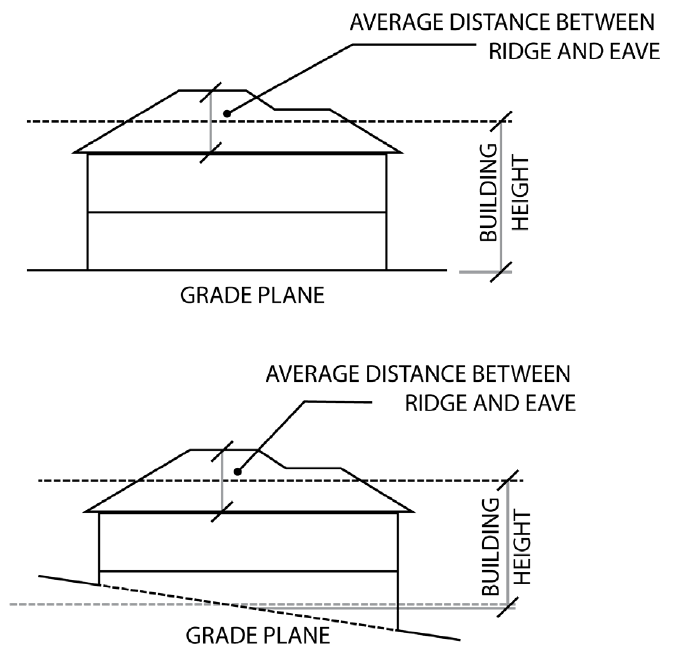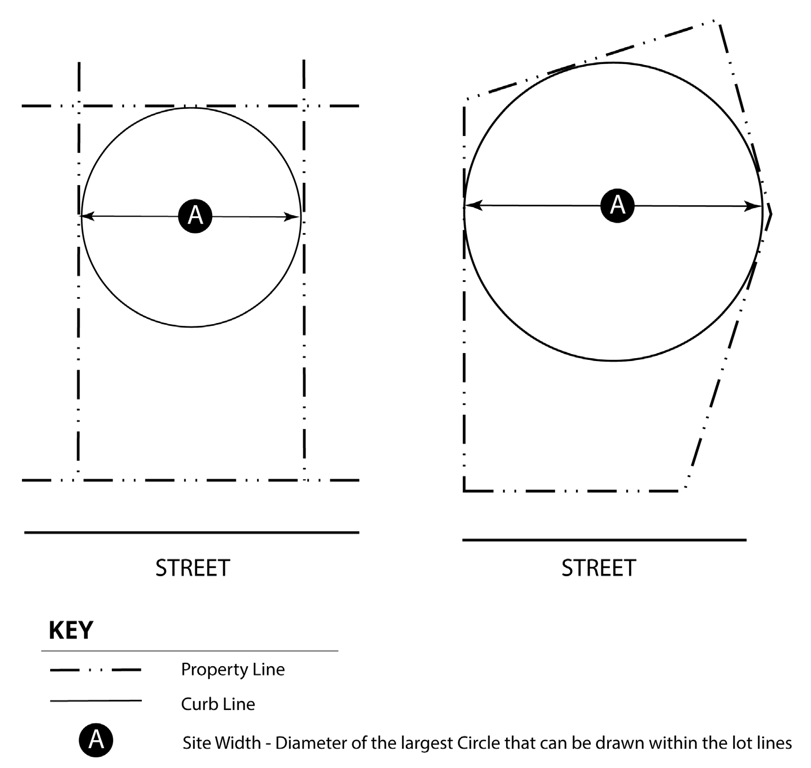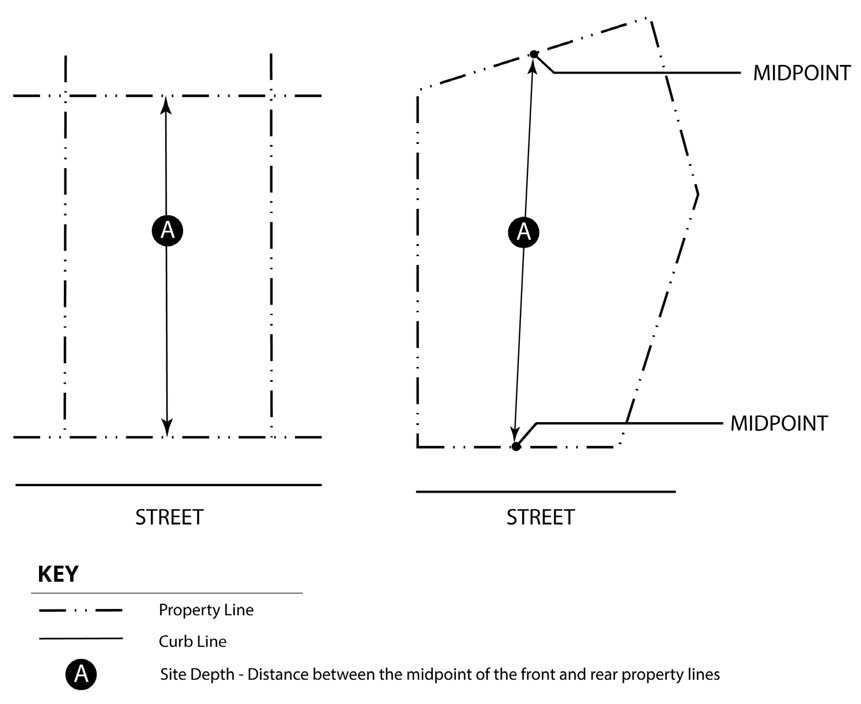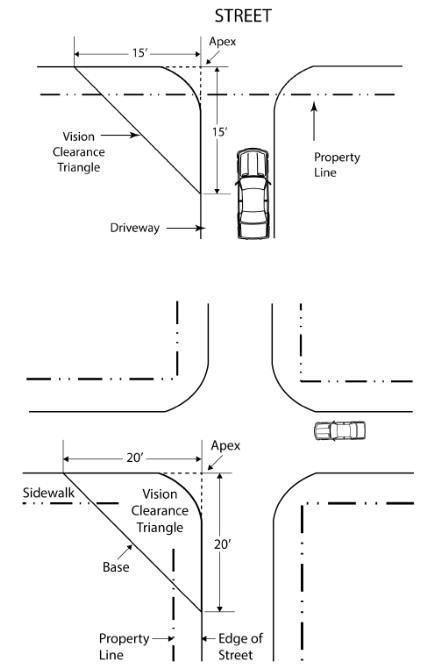Chapter 14.02.030
Rules of Measurement
Sections:
14.02.030.020 General Provisions.
14.02.030.040 Calculating Density.
14.02.030.050 Measuring Distances.
14.02.030.060 Measuring Height.
14.02.030.070 Measuring Lot Width and Depth.
14.02.030.080 Determining Floor Area.
14.02.030.090 Determining Floor Area Ratio.
14.02.030.100 Determining Lot Coverage.
14.02.030.110 Determining Lot Frontage.
14.02.030.120 Determining Setbacks (Yards).
14.02.030.130 Measuring Signs.
14.02.030.140 Measuring Intersection and Driveway Sight Distance Visibility.
14.02.030.010 Purpose.
The purpose of this chapter is to explain how various measurements referred to in this title are to be calculated.
(Ord. 1972, Repealed and Replaced, 02/22/2022)
14.02.030.020 General Provisions.
For all calculations, the applicant shall be responsible for supplying drawings illustrating the measurements that apply to a project. These drawings shall be drawn to scale and of sufficient detail to allow easy verification upon inspection by the Director of Community Development.
(Ord. 1972, Repealed and Replaced, 02/22/2022)
14.02.030.030 Fractions.
Whenever this title requires consideration of distances, parking spaces, dwelling units, or other aspects of land use and development or the physical environment expressed in numerical quantities, and the result of a calculation contains a fraction of a whole number, the results will be rounded as follows:
A. General Rounding. Fractions of one-half or greater shall be rounded up to the nearest whole number and fractions of less than one-half shall be rounded down to the nearest whole number, except as otherwise provided.
B. Rounding for Density. When calculating density, fractions of nine-tenths or greater shall be rounded up to the nearest whole number and fractions less than nine-tenths shall be rounded down to the nearest whole number.
C. Exception for State Affordable Housing Density Bonus. The calculation of fractions related to permitted bonus density units for projects eligible for bonus density pursuant to Government Code Section 65915 or any successor statute, and Chapter 14.09.210 of this code, any fractional number of units shall be rounded up to the next whole number.
(Ord. 1972, Repealed and Replaced, 02/22/2022)
14.02.030.040 Calculating Density.
Density is calculated by dividing the number of units by the developable area.
A. Developable Area. Developable area includes the following:
1. The entire area of the site except:
a. Areas with a slope of 25 percent or greater with a vertical change of 25 feet or more.
b. Creek ways below the stable top of bank, as determined by the City Engineer.
c. Public flood control channels and related rights-of-way and facilities.
d. Areas determined to be unbuildable due to geologic instability, as determined by the City Engineer.
e. Areas above the City’s applicable maximum water service elevation, as determined by the City Engineer.
f. Areas where development is precluded by existing easements and is not included in a required yard or open space.
g. Public parks, public street or alley right-of-way, and other property for public use which is proposed to be dedicated or sold to the City or public agency or maintained for the general public, for which compensation is provided in the form of fee credit or monetary compensation.
2. Areas of land dedicated to the City consistent with the following:
a. The land to be dedicated may be on or off site.
b. The dedication shall occur prior to the approval of an application for a residential project on the subject site.
c. The land to be dedicated would be required to be dedicated in conjunction with a future project approval or would be required for public improvements prior to project approval.
d. The land is dedicated to the City without any fee credit or monetary compensation.
e. The Director of Public Works determines that the timing and conditions of the proposed dedication are in the public’s best interest.
f. A written agreement, in a form approved by the Director of Community Development, shall be prepared by the applicant, and such agreement shall include the following information:
i. Specifies the acreage of the land area dedicated to the City.
ii. Identifies the site where the area of dedicated land will be included in the developable area calculation.
iii. A statement that the City shall consider the area of dedicated land as part of the developable area calculation when a residential development application is received for that site.
iv. A statement that the number of dwelling units allowed on any area of the site that was not dedicated to the City shall be determined through the project approval process.
v. A statement that the ability to include the area of dedicated land in the calculation of developable area shall take effect upon recordation of transfer of title for or dedication of the subject site to the City.
vi. A statement that the area of dedicated land is to be used in the calculation of developable area on the identified site and may not be transferred to another site.
(Ord. 1972, Repealed and Replaced, 02/22/2022)
14.02.030.050 Measuring Distances.
A. Measurements Are Shortest Distance. When measuring a required distance, such as the minimum distance between a structure and a lot line, the measurement is made at the closest or shortest distance between the two objects.
B. Distances Are Measured Horizontally. When determining distances for setbacks and structure dimensions, all distances are measured along a horizontal plane from the appropriate line, edge of building, structure, storage area, parking area, or other object. These distances are not measured by following the topography or slope of the land.
C. Measurements Involving a Structure. Measurements involving a structure are made to the closest support element of the structure. Structures or portions of structures that are entirely underground are not included in measuring required distances.
D. Measurement of Vehicle Stacking or Travel Areas. Measurement of a minimum travel distance for vehicles, such as garage entrance setbacks and stacking lane distances, are measured down the center of the vehicle travel area. For example, curving driveways and travel lanes are measured along the center arc of the driveway or traffic lane.
E. Measuring Radius. When a specified land use is required to be located a minimum distance from another land use, the minimum distance is measured in a straight line from all points along the lot line of the subject project, in all directions.
(Ord. 1972, Repealed and Replaced, 02/22/2022)
14.02.030.060 Measuring Height.
A. Measuring Building Height. Building height is measured from the grade plane to the average elevation between the eaves and the ridge for a hip, gable, or gambrel roof or the highest point on the roof for other roof forms.

FIGURE 14.02.030.A: MEASURING BUILDING HEIGHT
B. Measuring Other Structures. The height of other structures is measured as the vertical distance from the existing grade immediately under the structure to highest point of the structure, except as provided below:
1. Measuring Height of Fences or Walls. The height of a fence or wall is measured as the vertical distance from the finished grade level, as shown on approved grading plans, or the existing grade if there are no approved grading plans, on the side of the fence or wall on which the elevation is the greatest to the highest point of the fence or wall.
2. Measuring the Height of Decks. Deck height is determined by measuring from the ground to the top of the floor of the deck directly above the ground below.
C. Measuring the Number of Stories. In measuring the number of stories in a building, the following rules shall apply:
1. An interior balcony or mezzanine shall be counted as a full story if its floor area exceeds one-third of the total area of the nearest full floor directly below it or if it is enclosed on more than two sides.
2. A basement shall be counted as a full story if the vertical distance between finished grade and the finished surface of the floor above the basement is more than six feet at any point.
3. A story shall not exceed 25 feet in height from the upper surface of the floor to the ceiling above.
(Ord. 1972, Repealed and Replaced, 02/22/2022)
14.02.030.070 Measuring Lot Width and Depth.
A. Lot Width. Lot width is the diameter of the largest circle that may be inscribed within the lot lines of the lot.

14.02.030.B: MEASURING LOT WIDTH
B. Lot Depth. Lot depth is measured along a straight line down from the midpoint of the front property line of the lot to the midpoint of the rear property line or to the most distant point on any other lot line where there is no rear lot line.

14.02.030.C: MEASURING LOT DEPTH
(Ord. 1972, Repealed and Replaced, 02/22/2022)
14.02.030.080 Determining Floor Area.
The floor area of a building is the sum of the gross horizontal areas of all floors of a building or other enclosed structure, measured from the outside perimeter of the exterior walls and/or the centerline of interior walls.
A. Included in Floor Area. Floor area includes, but is not limited to, all living space (bedrooms, bathrooms, kitchens, hallways, common space, etc.) that is below the roof and within the outer surface of the main walls of principal or accessory buildings or the centerlines of party walls separating such buildings or portions thereof or within lines drawn parallel to and two feet within the roof line of any building without walls. In the case of a multi-story building that has covered or enclosed stairways, stairwells, or elevator shafts, the horizontal area of such features shall be counted only once at the floor level of their greatest area of horizontal extent.
B. Excluded From Floor Area. Floor area does not include mechanical, electrical, and communication equipment rooms that do not exceed two percent of the building’s gross floor area; bay windows or other architectural projections where the vertical distance between the lowest surface of the projection and the finished floor is 30 inches or greater; areas that qualify as usable open space; and in nonresidential buildings, areas used for off-street parking spaces or loading spaces, driveways, ramps between floors of a multi-level parking garage, and maneuvering aisles that are located below the finished grade of the property.
C. Nonresidential Uses. For nonresidential uses, gross floor area includes pedestrian access interior walkways or corridors, interior courtyards, walkways, paseos, or corridors covered by a roof or skylight. Nonresidential gross floor area does not include arcades, porticoes, and similar open areas that are located at or near street level and are accessible to the general public but are not designed or used as sales, display, storage, service, or production areas.
(Ord. 1972, Repealed and Replaced, 02/22/2022)
14.02.030.090 Determining Floor Area Ratio.
The floor area ratio (FAR) is the ratio of the floor area, excluding the areas described in Section 14.02.030.080, of all primary and accessory buildings on a site to the site area. To calculate the FAR, the total floor area is divided by the site area, and typically expressed as a decimal. For example, if the floor area of all buildings on a site totals 20,000 square feet, and the site area is 10,000 square feet, the FAR is expressed as 2.0.
(Ord. 1972, Repealed and Replaced, 02/22/2022)
14.02.030.100 Determining Lot Coverage.
Lot coverage is the total footprint area of all structures on a lot to the net lot area, typically expressed as a percentage. The footprints of all principal and accessory structures, including garages, carports, covered patios, and roofed porches, shall be summed in order to calculate lot coverage. The following structures shall be excluded from the calculation:
A. Unenclosed and unroofed decks, uncovered patio slab, porches, landings, balconies, and stairways less than four feet in height;
B. Eaves and roof overhangs projecting up to three feet from a wall;
C. Trellises and similar structures that have roofs that are at least 50 percent open to the sky through uniformly distributed openings;
D. Swimming pools and hot tubs that are not enclosed in roofed structures or decks; and
E. One small, nonhabitable accessory structure under 120 square feet. Structures above quantity of one shall be included in lot coverage.
(Ord. 1972, Repealed and Replaced, 02/22/2022)
14.02.030.110 Determining Lot Frontage.
A. Corner Lot. The front of a lot is the narrowest dimension of the lot with street frontage.
B. Through Lot. The front of a through lot abuts the street that neighboring lots use to provide primary access.
(Ord. 1972, Repealed and Replaced, 02/22/2022)
14.02.030.120 Determining Setbacks (Yards).
A setback line defining a required yard is parallel to and at the specified distance from the corresponding property line. Required setbacks shall be unobstructed from the ground to the sky except where allowed pursuant to Section 14.09.200.030, subject to compliance with the Building Code. The following special regulations for determining setbacks apply when a lot abuts a proposed street or alley.
A. Abutting Planned Street Expansions. If a property abuts an existing or proposed street for which the existing right-of-way is narrower than the right-of-way ultimately required for the street, the required setback shall be established from the future right-of-way rather than the property line.
B. Alleys.
1. If a side lot line abuts an alley, the yard shall be considered a rear yard.
2. In calculating the minimum yard for any lot with an interior side yard abutting an alley, no part of the width of the alley may be considered as part of the required yard.
(Ord. 1972, Repealed and Replaced, 02/22/2022)
14.02.030.130 Measuring Signs.
The calculations of measurements related to signs are described in Chapter 14.09.260 of this code.
(Ord. 1972, Repealed and Replaced, 02/22/2022)
14.02.030.140 Measuring Intersection and Driveway Sight Distance Visibility.
A. Location Restrictions. Except where specifically authorized in this chapter, obstructions over 36 inches in height, including fences, walls, hedges, signs, berms, landscaping and/or trees, may not be placed in the following locations (see Figure 14.02.030.D):
1. Street Intersections. Obstructions shall not be located within 20 feet from the intersection of two streets and/or alley rights-of-way along both streets and connecting lines across the property.
2. Private Driveways. Obstructions shall not be located within 15 feet from the intersection of a property line and a private driveway or alley.
3. Exceptions. An exception to the sight distance visibility location restrictions may be granted with approval of an adjustment, Chapter 14.09.310 of this code, where it can be demonstrated by an applicant that an obstruction identified in subsection A of this section will not impair the sight distance of vehicles on the street or on an access driveway.

FIGURE 14.02.030.D: MEASURING INTERSECTION AND DRIVEWAY SIGHT DISTANCE
(Ord. 1972, Repealed and Replaced, 02/22/2022)


